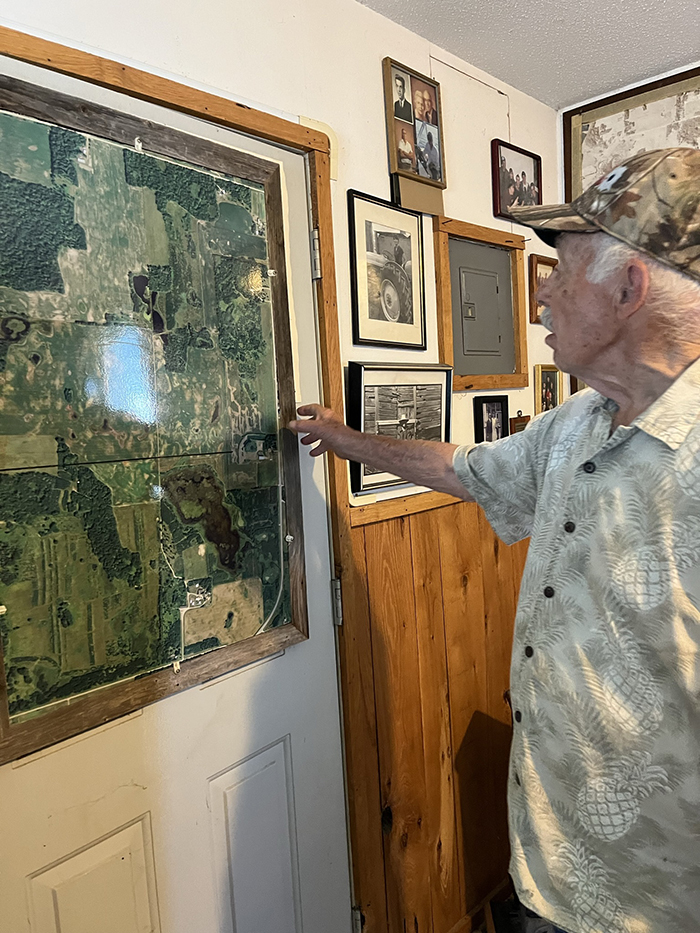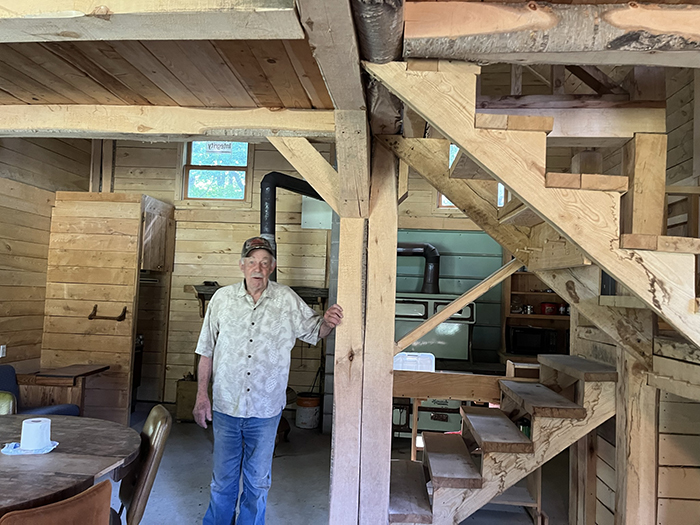Providing an oasis of nature on the Trails
NewsSports | Published on July 5, 2022 at 5:18pm GMT+0000 | Author: Chad Koenen
0
By Paula Wojcik
Special to the Dispatch
Just off Highway 67 north of New York Mills is a hidden treasure that Bob Sonnenberg is willing to share. What started as a small family farm has grown into nature-lover’s dream—13 miles of trails woven throughout nearly 700 acres of forest and agricultural land. ¶ Established in 1941 by Edward and Ethel Sonnenberg, the Sonnenberg Farm began as a small 160-acre farm. In 1963, Bob Sonnenberg bought the farm from his parents, but at the time was in Albuquerque working as an engineer. It wasn’t feasible for him to come back to work on the farm, so he managed it from afar and rented out the land to farmers. But as time went on, the woods called him home.
From the start of his return, Sonnenberg began developing and expanding the acreage into more than just a family farm.
“When opportunity showed up, I took advantage of it,” said Sonnenberg as he explained how his family’s 160-acre farm grew into a 700-acre masterpiece. “I would buy 80 acres at a time. A lot of the properties were land-locked, and once the owners realized I was willing to buy, they were eager to sell.”

Which is how Sonnenberg was able to purchase nine different contiguous properties to expand his farm and ultimately create the Sonnenberg Trails.
Sonnenberg began by rebuilding the entire homestead. In 1991 when he retired, Sonnenberg wanted to turn the property into a recreational farm.
“I wanted it to make it compatible and pay with both forest and agriculture,” said Sonnenberg. “I think I’ve accomplished that.”
Sonnenberg knew he had something special in the property. Afterall, as most farmers know, owning that many contiguous acres is not easy to come by. But more impressive than the acreage is what is on it—the juxtaposition of forest and agriculture.
Sonnenberg knew that he wanted to expand the forestry. To do that, he had to learn more about it. So Sonnenberg turned to whatever resources he could find to broaden his education and knowledge of forestry, and then he began planting trees.
“I was [basically] self-taught,” he said. “I learned what I could through whatever classes were available, and I like to think I have a pretty decent forestry background now.”
The Sonnenberg Trails are adorned with a variety of species of trees ranging from red and white pine and spruce to oak and ash trees among others.
“I’ve tried to plant more oak trees,” Sonnenberg said, but the deer tend to eat those before they really take hold.
Along the trails people can see multiple signs of deer and other wildlife, another facet of the beauty of the trails.
Experiencing the joy of nature is a primary benefit of the Sonnenberg Trails. Deer are abundant, as are many species of birds and other small animals. There is a beautiful pond located in the heart of the property where a pair of swans often take up residency. Families of ducks can also be seen inhabiting the wetland areas. There is even a drainage ditch where beaver have created a den. Not really what you want when trying to create a forest, but Sonnenberg is not concerned as they have not done much damage to the property. In fact, Sonnenberg is careful and knowledgeable in his efforts to control and sustain the wildlife—both flora and fauna.
Sonnenberg has divided the property into two sections. He allows deer hunting in certain areas to help control the population. He rents out portions of the property to hunters, and even has a hunting shelter in place where, in the past, a 90 plus gentleman could enjoy the hunt without having to brave the elements. It is a symbiotic relationship between the hunters, farmers, and anyone who wants to enjoy the property. As Sonnenberg pointed out the destruction to the trees from the deer, he knows that allowing hunting is a vital component to sustaining the forest. It is a balance that Sonnenberg has honed over the years.
His diligence has paid off. In recent years Sonnenberg opened his trails to the NY Mills High School cross country teams.
Head coach Greg Esala is grateful for the opportunity to train his runners on a “real” cross country course. Cross country running is all about experiencing natural terrain. Most high school cross country meets are held at golf courses as they allow for ample space to regulate the competition.
One would be hard-pressed to find natural, public terrain covering an expanse of three miles for multiple high school runners to adequately compete with the regulations and contingencies mandated by the league. This is where NY Mills High School has an advantage. For the past five years, Sonnenberg has opened his trails to them for their training and work-outs. They have even begun hosting their meets at the location as well.
At the first meet, Sonnenberg didn’t know what to expect.
“I wasn’t sure how well-attended the meets were. If we’d have enough parking and areas for people,” Sonnenberg admitted. “[Esala] said there would probably be about five buses and a few cars. As it turned out, a few turned out to be over 90 cars.”
The unexpected turn-out may have something to do with the increasing popularity of the sport, but more likely it was due to the rare setting.
“We really enjoy running on the trails at Sonnenberg’s,” said Esala. “The trails have hills and great views for us to observe as we work out. At our meets the runners love the trails due to this and the fact that we are not just on the usual golf course, but on a true cross country race route. As teams have found out about our race, we have decided to hold two races so that more teams can be involved.”
With the gaining popularity of the NY Mills meets, one drawback is the limited space for spectators to view the race. However, it is a small price to pay.
“The wilderness is so beautiful,” said Breck Hensch, a 2022 graduate of NY Mills High School and avid cross-country runner for the past four years. “It is a lot different experience. With more bumps and hills, you have really watch your step.” Hensch and his teammates really respect the opportunity as the terrain is not only beautiful, but also challenging.
Esala explained that uneven, natural terrain really impacts the core workout.
“This is a totally different workout than just running on roads or streets,” he said. “The uneven ground aids us with a great core workout. Also, as we run we often see wildlife such as turkeys, ducks, geese and numerous deer!”
Hensch agreed with his coach.
“It is more challenging, but also more fun,” said Hensch. “The different views and scenery make it like you’re running for fun. You forget you’re competing. So many other teams have told us that we have the best meets because of this. The views are just so much better.”
The cross country team practices on the trails about once a week or so beginning in July, and they hold our meets before bow hunting season in order to not disturb the hunters who rent from Sonnenberg. This still leaves ample opportunity for others to enjoy the trails.
It was at a cross country meet that Sonnenberg realized how other people would benefit from the trails. Seeing the youth enjoying the trails, Sonnenberg wanted to give that opportunity to families to introduce their youngsters to nature. With 13 miles of trails that range in length, distance, terrain, there is something for everyone.
“There are some intertwining smaller trails where the underbrush and lower branches have been removed for families with small children to get up close and explore the trees,” said Sonnenberg.
And there are longer trails further out for those who want a little more challenging hike.
“The trail along the pond are the favorites of the cross country runners,” said Sonnenberg. “The view and the wildlife is nice.”
Sonnenberg plans to open his trails to the public the weekend of July 23. There is no charge to use the trails, but Sonnenberg does ask that visitors sign in.
“I have a little hunting shed that I’m going to use as kind of a reception area,” said Sonnenberg. “I’ll have a guest book and a map of the trails will be posted. It’ll be free for people to use the trails, but there will be a benefit box there if anyone wants to contribute.”
Aside from the deer hunting season, the trails will be open and groomed year round as the weather allows.
Sonnenberg is excited to share his land with the public.
“This land has been adapted to demonstrate the compatibility of forestry and agriculture,” he said. “Not too many people pay attention to that.”
At 94 years young, Sonnenberg continues to maintain the acreage with regular rides along the trails for inspections, working with the farmers who lease his land for crops, and working with logging companies to harvest older trees to allow for new growth.
“There is a section of trees that are about 35 years old and will be harvested when they are closer to 75 years. I plan to be around for that,” said Sonnenberg with a sly smile. “I don’t work hard, but I work every day.” Sonnenberg works with the help of nature, “There are natural trails through the woods established by the wildlife and the way the trees naturally seed and grow. I just help it along. As you can see, nature does a pretty good job on its own.”

